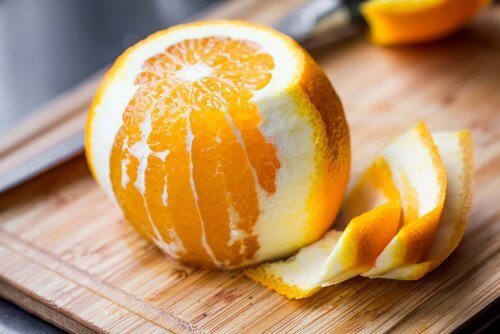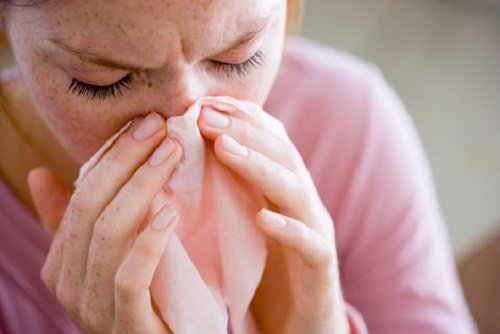8 Medicinal Properties of Orange Peel You May Ignore


Reviewed and approved by the nutritionist Maria Patricia Pinero Corredor
Everyone around the world likes an orange but most throw away the peel without realizing these contain lots of nutrients.
Many people just throw them in the trash. However, they don’t know that orange peels have many health properties, according to various studies. Thus, they help reduce the risks of disease.
An orange peel isn’t as tasty as the fruit. However, its active compounds are reason enough to consider adding it to your diet.
Still, there are many recipes that you can use them in to enjoy their exotic, citric touch in spite of their bitter flavor.
In this article, we’re going to share eight of the medicinal properties of an orange peel you should take advantage of.
The properties of orange peel
The main antioxidant nutrient in orange peels is hesperidin (33.39 mg/g), which has properties that protect the vascular system. In that respect, it acts on the microcirculation, increasing resistance and permeability. It also protects the tissue that lines the inside of the arteries.
It also has anti-inflammatory and analgesic properties. Diosmin, another component of orange peel, together with hesperidin, reduces edema caused by venous obstruction.
Furthermore, the essential oil of the Citrus sinensis orange peel has antimicrobial and anticancer activity (at the end of the article we’ll show you how to extract it).
Together with limonene, which is the major compound in the oil, in laboratory tests it has shown chemopreventive and therapeutic effects against the formation of breast tumors.
Finally, Citrus sinensis essential oil is one of the main ingredients in perfume. And because of its antioxidant properties, cosmetic forms are under development for the skin: dressings, patches and facial masks.
Let’s take a closer look at the health properties of orange peel:
1. Orange peel may reduce your risk of high cholesterol
Orange peels have phytochemicals and flavonoids. These can be a natural remedy for people with bad levels of cholesterol.
These antioxidants clean your arteries. They also may reduce the formation of plaque that causes blockages and blood clots.
At the same time, they have benefits for your cardiovascular health. This is because it reduces the risk of hypertension, heart attacks, and strokes.
2. It relieves heartburn
The active compounds in these peels have an alkaline effect that reduces stomach acid.
Drinking them, either in shakes or infusions, balances your digestive pH level. It also reduces the over-production of acid when you’re having digestive problems.
In cases of severe and repetitive heartburn, you should drink them once a day for 20 days.
3. It relieves digestive problems

Estimates indicate that every 100 grams of orange peels give you up to 10.6 grams of fiber. This is an essential nutrient for digestive health.
Eating them on a regular basis speeds up bowel movements. At the same time, they encourage waste removal.
This is one of the best homemade remedies for reducing your risk of irritable bowel syndrome, diarrhea, and inflammatory diseases.
In addition, it’s quite soothing and has positive effects on the microbial flora that protects the intestine.
4. It has antibacterial properties
The natural extracts in this ingredient have high phenol and antioxidant contents. At the same time, they have antimicrobial and antibacterial properties.
Both inside and out, they can counteract a series of harmful pathogens, including E. coli or Listeria monocytogenes.
5. Orange peel can prevent respiratory diseases and relieve the symptoms

Orange peel has up to 10 times more vitamin C than orange juice. As a result, they strengthen your immune system.
This antioxidant nutrient slows the proliferation of viruses and bacteria. It also strengthens your defense mechanisms and prevents respiratory diseases such as:
- Bronchitis
- Colds
- The flu
- Allergies
- Asthma
- Lung cancer
This article may interest you 9 Foods That Strengthen Your Immune System
6. It improves your dental health
Chewing orange peel helps:
- Freshens your breath
- Controls bacteria
- Reduces your risks of yellow spots on your teeth
The extracts and essential oils offer a protective barrier against the harmful effects of bacterial plaque and infections associated with it.
Chewing orange peels is also recommended for patients with sensitive teeth. This is because applying it reduces the symptoms. You can apply grated orange peels like a paste or rub the inner part against your teeth.
7. It helps you lose weight

This food is low in calories, has fiber, and has detoxifying properties that help you lose weight.
Drinking an infusion of orange peels or adding them to other recipes encourages your body’s cleansing processes. They also help you feel fuller for longer. Thus, it prevents overeating.
8. The orange peel helps improve your skin’s appearance
This peel can also provide interesting external benefits you should take advantage of for health and aesthetics.
Its high vitamin C contents helps reduce your risk of liver spots and other marks caused by premature aging.
Through its extracts, orange peels help you clear and cover those small spots. This includes the ones that are caused by sun exposure, burns, and toxins.
Orange peel infusions act as natural tonics. This is because they clean your pores deeply. This prevents the formation of blackheads, pimples, and acne.
As you can see, this part of oranges you usually throw away is an excellent aid for your health. Enjoy orange peels grated, benefit from them as an infusion, or simply enjoy their exotic flavor in your dishes.
How to extract the essential oil from the peel of the Citrus sinensis orange
Peel the oranges and remove the white parts of the peel. Place them in a glass jar and cover them with vodka. Close the jar and shake vigorously for a few seconds. Let the liquid macerate for at least a week, shaking it vigorously several times a day. After this time, pass it through a coffee strainer and remove the solids.
Let the orange liquid stand in a ventilated place for the alcohol to evaporate. After a few days, when the smell of alcohol has disappeared, package the oil in a dark glass jar.
That’s it. You can now benefit from all of the incredible properties of orange peel!
All cited sources were thoroughly reviewed by our team to ensure their quality, reliability, currency, and validity. The bibliography of this article was considered reliable and of academic or scientific accuracy.
- Ayala, J. R., Montero, G., Coronado, M. A., García, C., Curiel-Alvarez, M. A., León, J. A., … & Montes, D. G. (2021). Characterization of orange peel waste and valorization to obtain reducing sugars. Molecules, 26(5), 1-14. Disponible en: https://www.ncbi.nlm.nih.gov/pmc/articles/PMC7961523/
- Core, J. (2003, September 12). Orange Peel Carbohydrates May Have Health-Promoting Properties. U.S. Department of Agriculture [USDE]. Disponible en: https://www.ars.usda.gov/news-events/news/research-news/2003/orange-peel-carbohydrates-may-have-health-promoting-properties/
- Hasan, M. M., Roy, P., Alam, M., Hoque, M. M. & Zzaman, W. (2022). Antimicrobial activity of peels and physicochemical properties of juice prepared from indigenous citrus fruits of Sylhet region, Bangladesh. Heliyon, 8(7), 1-7. Disponible en: https://www.ncbi.nlm.nih.gov/pmc/articles/PMC9293629/
- Kang, S., Song, S., Lee, J., Chang, H. & Lee, S. (2018). Clinical investigations of the effect of Citrus unshiu peel pellet on obesity and lipid profile. Evidence-based complementary and alternative medicine, 2018, 1-6. Disponible en: https://www.ncbi.nlm.nih.gov/pmc/articles/PMC6169216/
- Koolaji, N., Shammugasamy, B., Schindeler, A., Dong, Q., Dehghani, F. & Valtchev, P. (2020). Citrus peel flavonoids as potential cancer prevention agents. Current developments in nutrition, 4(5), 1-20. Disponible en: https://www.ncbi.nlm.nih.gov/pmc/articles/PMC7199889/
- Maldonado, M. J. M., Xavier, P. C. N., Martins, A. S. & Palhares, D. B. (2020). Hesperidin Flavonoids from Orange Peel Show Benefits for Human Health. physiology, 233(9), 6544-6560. Disponible en: https://juniperpublishers.com/artoaj/ARTOAJ.MS.ID.556292.php
- Shetty, S. B., Mahin-Syed-Ismail, P., Varghese, S., Thomas-George, B., Kandathil-Thajuraj, P., Baby, D. & Devang-Divakar, D. (2016). Antimicrobial effects of Citrus sinensis peel extracts against dental caries bacteria: An in vitro study. Journal of clinical and experimental dentistry, 8(1), 1-7. Disponible en: https://pubmed.ncbi.nlm.nih.gov/26855710/
- Singanusong, R., Nipornram, S., Tochampa, W. & Rattanatraiwong, P. (2015). Low power ultrasound-assisted extraction of phenolic compounds from mandarin (Citrus reticulata Blanco cv. Sainampueng) and lime (Citrus aurantifolia) peels and the antioxidant. Food Analytical Methods, 8(5), 1112-1123. Disponible en: https://link.springer.com/article/10.1007/s12161-014-9992-6
- Stohs, S. J., Preuss, H. G. & Shara, M. (2012). A review of the human clinical studies involving Citrus aurantium (bitter orange) extract and its primary protoalkaloid p-synephrine. International journal of medical sciences, 9(7), 527-538. Disponible en: https://www.ncbi.nlm.nih.gov/pmc/articles/PMC3444973/
- Tejada-Ortigoza, V., García-Amezquita, L. E., Serna-Saldívar, S. O. & Welti-Chanes, J. (2017). The dietary fiber profile of fruit peels and functionality modifications induced by high hydrostatic pressure treatments. Food Science and Technology International, 23(5), 396-402. Disponible en: https://pubmed.ncbi.nlm.nih.gov/28675969/
- Teixeira, F., Santos, B. A. D., Nunes, G., Soares, J. M., Amaral, L. A. D., Souza, G. H. O. D. & Novello, D. (2020). Addition of orange peel in orange jam: evaluation of sensory, physicochemical, and nutritional characteristics. Molecules, 25(7), 1-14. Disponible en: https://www.ncbi.nlm.nih.gov/pmc/articles/PMC7180482/
- Wang, L., Xu, H., Yuan, F., Fan, R. & Gao, Y. (2015). Preparation and physicochemical properties of soluble dietary fiber from orange peel assisted by steam explosion and dilute acid soaking. Food Chemistry, 185, 90-98. Disponible en: https://pubmed.ncbi.nlm.nih.gov/25952845/
- Yoshizaki, N., Fujii, T., Masaki, H., Okubo, T., Shimada, K. & Hashizume, R. (2014). Orange peel extract, containing high levels of polymethoxyflavonoid, suppressed UVB‐induced COX‐2 expression and PGE 2 production in HaCaT cells through PPAR‐γ activation. Experimental Dermatology, 23, 18-22. Disponible en: https://pubmed.ncbi.nlm.nih.gov/25234831/
- Zhou, L., Gu, W., Kui, F., Gao, F., Niu, Y., Li, W. & Du, G. (2021). The mechanism and candidate compounds of aged citrus peel (chenpi) preventing chronic obstructive pulmonary disease and its progression to lung cancer. Food & Nutrition Research, 65, 1-14. Disponible en: https://www.ncbi.nlm.nih.gov/pmc/articles/PMC8254466/
This text is provided for informational purposes only and does not replace consultation with a professional. If in doubt, consult your specialist.








